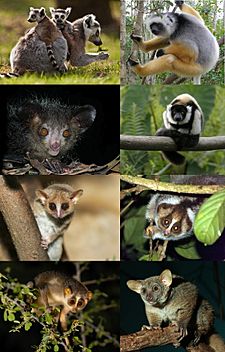Lemuriformes facts for kids
Quick facts for kids Lemuriformes |
|
|---|---|
 |
|
| A sample of lemuriform diversity. from top, left to right: Lemur, Propithecus, Daubentonia, Varecia, Microcebus, Nycticebus, Loris, Otolemur. |
|
| Scientific classification | |
| Kingdom: | |
| Class: | |
| Order: | |
| Suborder: | |
| Infraorder: |
Lemuriformes
|
| Superfamilies | |


Lemuriformes are a special group of primates. They include the amazing lemurs from the island of Madagascar. This group also has the galagos and lorises from Africa and Asia. These animals are all related, even though they live in different parts of the world.
Scientists group animals based on how they are related. The lorises and lemurs are part of a "monophyletic clade." This means they all came from a single common ancestor. However, some scientists prefer to put lorises in their own separate group called Lorisiformes.
Contents
How Lemuriformes Evolved
The exact beginnings of Lemuriformes are a bit of a mystery. Scientists are still debating how they first appeared. This is because there are not many clear fossils that show how they changed over time.
Early Primate History
Scientists use something called a "molecular clock" to guess when animals separated. This method looks at changes in DNA over time. Based on this, lemurs and lorisoids (lorises and galagos) likely split up in Africa. This happened about 62 million years ago (mya), during a time called the Paleocene epoch.
Lemurs Reach Madagascar
Between 47 and 54 million years ago, lemurs made an incredible journey. They traveled from Africa to Madagascar by "rafting." This means they likely floated across the ocean on natural rafts of plants and trees. Once they arrived, they found a new home with no other primates.
Because they were isolated, lemurs changed and grew into many different types. They filled many "ecological niches." This means they took on roles that monkeys and apes often fill in other parts of the world today.
Lorises and Galagos in Africa and Asia
In Africa, the lorises and galagos separated from each other around 40 million years ago. This happened during the Eocene epoch. Unlike the lemurs in Madagascar, these animals had to compete for food and space. They shared their habitats with monkeys, apes, and many other mammals.
What Are Adapiformes?
Adapiforms are an extinct group of primates. Their skeletons look very similar to those of modern lemurs and lorises. Because of these similarities, scientists often think of them as "primitive" strepsirrhines. This means they are very old members of the group that includes lemurs and lorises.
Some researchers believe adapiforms were ancestors of living strepsirrhines. Others see them as a "sister group," meaning they are closely related but not direct ancestors. Their exact place in the primate family tree is still being studied. Sometimes they are placed in their own group, and sometimes they are included as families within the Lemuriformes.
See also
 In Spanish: Lemuriformes para niños
In Spanish: Lemuriformes para niños

